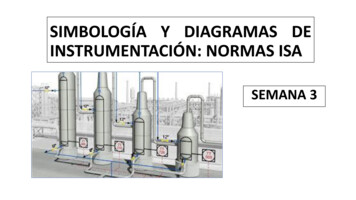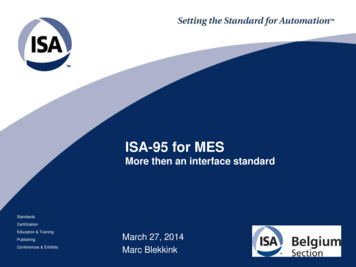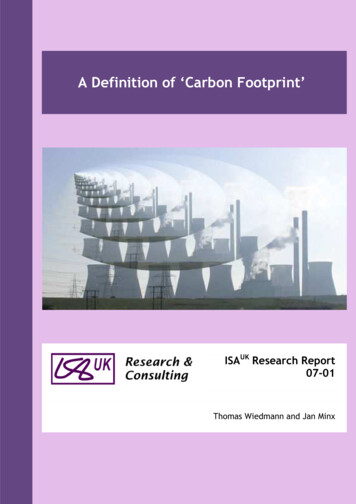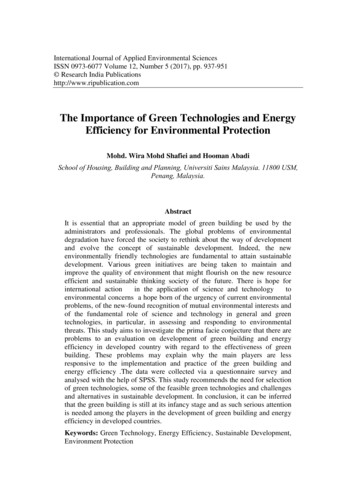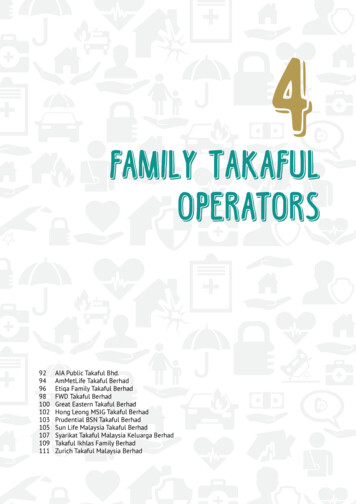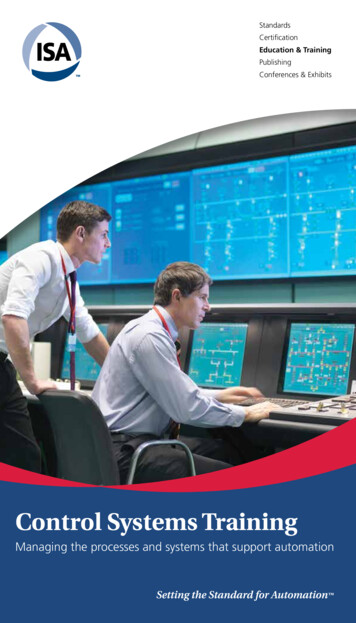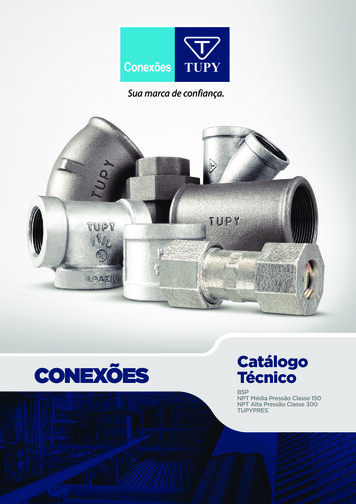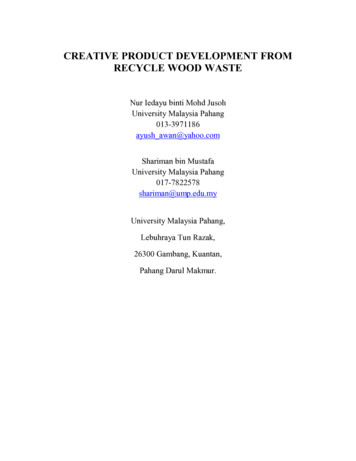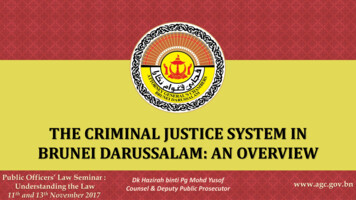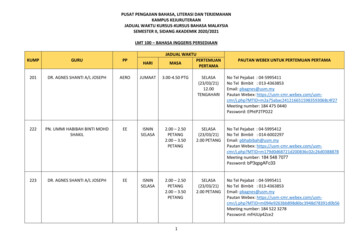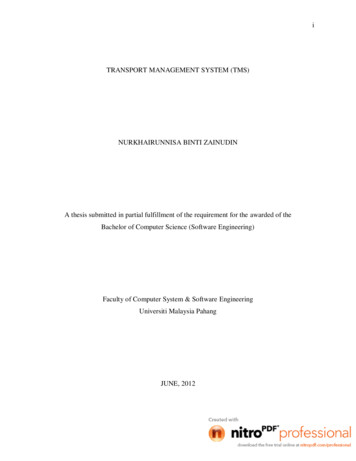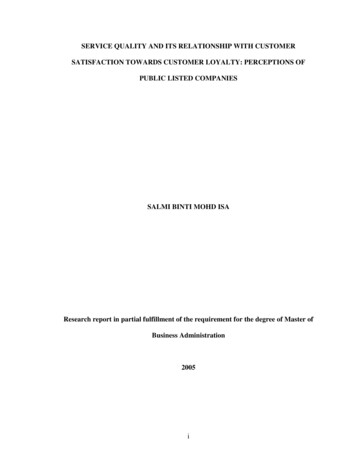
Transcription
SERVICE QUALITY AND ITS RELATIONSHIP WITH CUSTOMERSATISFACTION TOWARDS CUSTOMER LOYALTY: PERCEPTIONS OFPUBLIC LISTED COMPANIESSALMI BINTI MOHD ISAResearch report in partial fulfillment of the requirement for the degree of Master ofBusiness Administration2005i
ACKNOWLEDGEMENTIn the name of Allah s.w.t ., Most Beneficent and Most Merciful. Praise and thanks toAllah s.w.t for giving me the strength to complete this study. I am very grateful to mysupervisors, Associate Professor Dr Hasnah Haron and Associate Professor Dr IshakIsmail for their full guidance, insight, attention and encouragement throughout thisresearch project. Thanks for everything!My sincere appreciation and big thanks are dedicated to all my respondents for theirvaluable feedbacks. Their willingness to answer my questionnaire in a time given is muchhelpful for me to run this research smoothly. Without their participation, this research isobviously could not be well performed. I am also would like to express my thankful to allcourse mates and colleagues for their support and encouragement during my study. To allthose who had directly or indirectly contributed to the completion of this research, Iextended my deepest appreciation.Last but not least, my greatest appreciation goes to my beloved family and my fiancé fortheir endless prayer and support. With their love, understanding and priceless motivationhas brought me to this success.ii
TABLE OF CONTENTSPageiTitle pageAcknowledgementiiTable of ContentsList of TablesList of ION1.1OverviewBackground of the Study1.21.3Problem Statement1.4Research Objectives1.5Research Questions1.6Significance of the Study1.6.1 Benefit to Customers1.6.2 Benefit to Practitioners1.7Definition of Key Terms1.7.1 Service Quality1.7.2 Service Quality Dimensions1.7.3 Customer Satisfaction1.7.4 Customer Loyalty1.8Organization of Remaining Chapters12455667778889Chapter2LITERATURE REVIEW2.1Introduction2.2Service and Service Quality2.3Conceptualization and Operationalization of Service Quality2.4The SERVQUAL Model and its Underlying TheoriesCustomer Satisfaction2.52.6Customer LoyaltyAudit Firm Research2.72.8Theoretical Framework2.9Hypotheses Development2.9.1 The Significance Difference of SERVQUAL Gap2.9.2 The Relationship between Service Quality and CustomerSatisfaction2.9.3 The Relationship between Customer Satisfaction andCustomer Loyalty2.9.4 The Relationship between Service Quality and CustomerLoyalty through Customer Satisfactioniii10101314192123252626293031
2.10Summary32Chapter3RESEARCH METHODOLOGY3.1Introduction3.2Research Design3.3Variables3.4Population/Sample3.4.1 Unit of Analysis3.4.2 Sample size3.5Procedure3.5.1 Data Collection Method3.5.2 Questionnaire Design3.6Measurement3.6.1 Perceived Service Quality Dimension3.6.2 Service Quality-Customer Expectation and CustomerPerception3.6.3 Customer Satisfaction3.6.4 Customer Loyalty3.7Data AnalysisSummary3.8Chapter4DATA ANALYSIS AND RESULTS4.1Introduction4.2Profile of the RespondentsProfile of the Organizations4.34.4Reliability of Dimensions4.5Correlation Analysis4.6Importance of the Five Dimensions on Overall Service Quality4.7The Significance Difference of SERVQUAL GapThe Relationship between Service Quality and Customer Satisfaction4.84.9The Relationship between Customer Satisfaction and CustomerLoyalty4.10 The Relationship between Service Quality and Customer LoyaltyThrough Customer Satisfaction4.11 Summary of FindingsChapter5DISCUSSION AND CONCLUSION5.1Introduction5.2Recapitulation of the Findings5.3Discussion on the Findings5.4Implications5.5Limitations5.6Future 394040414142444547485153546063636470727273
REFERENCESAPPENDICESAppendix IAppendix IITable No3.53.6.14.24.34.44.54.64.74.84.94.10 (1)4.10 (2)4.10 (3)4.10 (4)4.115.3Figure No.2.12.8LIST OF TABLESTitle of TableResponse RateService Quality DimensionFrequency and Percentage of Respondent’s ProfileRespondent’s Organization ProfileCronbach’s Alpha ScoresPearson’s Correlation Coefficients of the StudyVariablesMean Scores of Expectations and Perceptions andTheir Relative ImportanceSummary of T-Test ResultsRegression Results of Service Quality andCustomer SatisfactionRegression Results of Customer Satisfaction andCustomer LoyaltyResults of Model OneResults of Model FourOverall Results of all ModelResults of Mediating VariableSummary of FindingsResults of Mediated Regression AnalysisLIST OF FIGURESTitle of FigureConceptual Model of Service QualitySchematic Diagram of the Research ModelvPage36384243444648505253575859596169Page1525
ABSTRAKKajian ini dijalankan bertujuan untuk menilai kualiti perkhidmatan yang ditawarkan olehfirma audit dan mengkaji hubungan di antara kualiti perkhidmatan, kepuasan dankesetiaan pelanggan terhadap perkhidmatan yang ditawarkan oleh firma audit. ModelSERVQUAL akan digunakan bagi mengukur tanggapan dan harapan klien (public listedcompanies )dengan perkhidmatan yang diterima oleh mereka. Borang soal selidiksebanyak 500 telah diagihkan kepada klien yang pernah menerima perkhidmatan auditdari firma audit. Kaedah persampelan mudah dipilih untuk menentukan saiz sampel dansebanyak 115 responden telah memberi kerjasama dengan menjawab soalan soal selidikdi dalam tempoh masa yang ditetapkan. Jurang di antara SERVQUAL telah dikaji dansebanyak empat andaian utama (hipotesis) telah dibuat bagi memenuhi objektif kajian ini.Setiap hasil kajian telah dilaporkan sepenuhnya selaras dengan objektif kajian.Responden telah diminta untuk mengklasifikasikan harapan mereka ke atas perkhidmatanyang diterima. Seperti yang dijangka dimensi kebolehpercayaan (“reliability”) telahdiklasifikasi sebagai dimensi yang paling penting. Hasil kajian juga menunjukkanterdapat jurang perbezaan di antara empat dimensi lain kecuali dimensi boleh nampak(“tangible”). Dengan kata lain klien hanya berpuas hati dengan dimensi ini tapi tidakpada empat dimensi lain. Hubungan di antara kepuasan pelanggan terhadap kesetiaanmenunjukan nilai signifikasi yang rendah kerana faktor latar belakang industri itu sendiri.Kepuasanpelangganjugamempunyaipengaruhyang kuatdengandimensikebolehpercayaan untuk menjadikan klien setia terhadap perkhidmatan yang ditawarkan.Kesimpulannya, hasil kajian didapati dapat membantu firma audit meningkatkan mutuperkhidmatan mereka di masa akan datang.vi
ABSTRACTThis research was conducted to find and get a better understanding of service qualitylevel and to examine the relationship between service quality, customer satisfaction andcustomer loyalty with the services offered by the audit firms. SERVQUAL model will beused to measure the public listed companies perception and expectation with the auditservices received. Questionnaires were sent to 500 audit clients (public listed companies)who engaged the audit services from audit firms. Convenient sampling method was usedto determine the sample size and 115 respondents had given their prompt feedback withinthe suggested time frame. The SERVQUAL gap has been measured and four majorhypotheses were developed in order to meet the research objectives. Each of everyresearch questions asked will be answered and reported accordingly based on theinsightful findings results. Respondents were asked to rank their expectation of servicequality dimensions and as per expected the Reliability dimension was ranked as numberone. The results also show there were negative gap for Reliability, Responsiveness,Assurance and Empathy dimension and a positive gap for Tangibles dimension. Meaningto say that audit clients were dissatisfied with those four dimensions except for Tangiblesdimension. The relationship between customer satisfaction and customer loyalty showeda very low significant value due to the industry characteristic and background. Reliabilitydimension was also reported to have a full mediating effect to customer loyalty. Thisfinding will enable audit firms to give more attention on this service dimension in orderto ensure their audit clients are being loyal to them. All findings gathered in this researchare very useful to the audit firms to enhance their service quality level with their auditclients. Thus, their client expectation will be fulfilled in the future.vii
viii
Chapter 1INTRODUCTION1.1OverviewThe rapid growth of service sectors all over the world and the deregulation of manyservices industries have lead researchers with an interest in quality issues to theimportance of acquiring more understanding about service quality. It is recognized thathigh quality service is essential for firms that want to be successful in their business(Parasuraman et al., 1998; Rust & Oliver, 1994). It leads to customer loyalty (Lewis1994), higher profitability (Gundersen, Heide & Olsson, 1996) and lower cost (Grant1998). Most would agree without any prompting on the importance of offering theircustomers with service quality.Service quality, customer satisfaction and customer loyalty are three elements that manyservices firms would gladly profess to be striving to provide to their customers.Companies of various shades, the popular business press, as well as business schools inparticular have relentlessly expounded service quality.Recent research indicates that these three concepts are quite distinct. Customersatisfaction or dissatisfaction results from experiencing a service quality encounter andcomparing that encounter with what was expected (Oliver, 1980). Whereby perceivedservice quality can be defined as the customer’s judgement about the superiority orexcellence of a product while perceived value is the customer’s overall assessment of theutility of a product based on perceptions of what is received and what is given (Zeithaml,1
1988). The dimensions underlying quality are fairly specific while satisfaction judgementhas a broader range of dimensions that also include quality aspects (Oliver, 1993).Moreover, satisfaction assessments require customer experience while quality does not(Bolton & Drew, 1991; Boulding, 1993; Cronin & 1992;Brown, 1993).Many customer satisfaction studies have concluded that there is a significant relationshipbetween customer satisfaction and loyalty. With consistent findings that service qualityand satisfaction are different constructs, and that service quality leads to customersatisfaction, the research interest moved to studying the linkages between service qualityand customer satisfaction and customer loyalty or retention.1.2Background of the StudyThe research is intended to assist audit firm in measuring expectations-perceptions gap todetermine the customer’s view (public listed companies) of the service quality offered byaudit firm. It tries to determine whether there is evidence that the SERVQUALdimensions are relevant to audit firm. The research also tries to examine the relationshipbetween customer satisfaction and loyalty that customer perceives as offering “quality”and whether this strategy improves the opportunity to attract repeat business.The SERVQUAL model was used to measure service quality despite the criticisms of theinstrument. The research attempts to indicate which dimensions are most relevant in audit2
firm services by considering all the five dimensions proposed by Parasuraman, Zeithamland Berry.The research was conducted for a practical purpose i.e. identify areas where quality isperceived by customer to be an issue. To this extent the methodology, presentation, andanalysis were in line with the requirements specified by audit firm to measure theircustomer satisfaction and loyalty.1.3Problem StatementMost of the studies consider delivering quality service as an essential strategy for successand survival for any organization. A principle emphasis of recent academic andmanagerial inquiry has focused on determining what service quality means, developingappropriate measures, and creating market-focused strategies to meet customer’sexpectation.Husna, (2004) reported, concluded that it is important for audit firms to adopt servicequality program to improve ways of providing products and services to their customers.The study also has developed an instrument to measure service quality in audit firms withfive dimensions namely: SERVQUAL. As discussed in previous research, her researchhas used the SERVQUAL model to test the validity of service quality by audit clients(SME). The study indicates that reliability was the most important variable indetermining quality service.3
However, Small Medium Enterprise (SME) is not a good sample because they did not allservices that offered by audit firms. The study also examined the direct relationshipbetween SERQUAL offered by audit firms and its client’s loyalty as it was assumed thatSERVQUAL could be equated to quality service.Husna et al (2004) studied only 19 items upon 22 items of the SERVQUAL items.Consisting of a 22-item, SERVQUAL is based on the idea that service quality is derivedfrom the difference between consumers’ expectations about performance of a generalclass of service providers and their assessment of the actual performance of a specificfirm within that class. Service quality has been described as a form of attitude, related butnot equivalent to satisfaction, the results from the comparison of expectations withperformance (Parasuraman,et al., 1988). So, a 22-item of SERVQUAL will be used inthis study. Service quality is defined as the gap between expected service and perceptionof service actually received. A number of studies suggest that there is a significantpositive relationship between customer satisfaction and customer loyalty (Anderson andSulivan, 1993; Cronin, Brady & Hult, 2000; Shemwell, 1988;Taylor & Baker, 1994).This study will then try to determine the factors influences customer satisfaction and theeffect of customer satisfaction on customer loyalty.1.4Research ObjectivesThe main objectives of this study are to examine the impact of service quality andcustomer loyalty through customer satisfaction. The objectives are:1. To determine the relative importance of each of the service quality dimensions.4
2. To determine the expectations and perceptions of audit clients’ regarding theservices offered by audit firms.3. To find whether there is a significant difference between perception andexpectation for each of the five service quality dimensions.4. To examine the relationship of service quality to customer satisfaction.5. To examine the relationship of customer satisfaction to customer loyalty.6. To examine whether customer satisfaction mediate the relationship of servicequality to customer loyalty.1.5Research QuestionsThis study will analyze and determine the following questions:1. What are the most important dimensions of service quality from audit firm asperceived by public listed companies?2. What are the expectations and perceptions of the current level of service of theaudit firm along five service dimensions?3. What are the gap of expectation and perception each of the service qualitydimensions?4. What is the relationship of service quality to customer satisfaction?5. What is the relationship between customer satisfaction and customer loyalty?6. Does customer satisfaction mediate the relationship of service quality to customerloyalty?5
1.6Significance of the StudyUnderstanding of the new concept in business is very important for developing aneffective marketing strategy, in order to regulate marketing practice or to cause sociallydesirable behaviors. Although it is generally accepted that quality and customersatisfaction do have positive impact on outcomes such loyalty but the precise nature ofthe relationship has been opened to debate. Therefore, the research is hoped to shed lightson these issues.In the services industry, customers (public listed companies) may be described as being"loyal" because they tend to choose a certain services of audit firm more often thanothers. Note the use of the word "choose" though; customer loyalty becomes evidentwhen choices are made and actions taken by customers. Customers may express highsatisfaction levels with a company in a survey, but satisfaction does not equal loyalty.Loyalty is demonstrated by the actions of the customer; customers can be very satisfiedand still not be loyal. Customer’s feedback data based on this study can tell whichcustomers are most likely to respond with satisfaction and become loyal. The study willalso give benefits to:1.6.1 Benefits to customersThe importance of delivering superior service quality is becoming increasingly magnifiedas competition intensifies throughout the service industry. A superior service quality istoday’s most attractive bait for acquiring and retaining customers. The benefits tocustomers are that they can attain better service and thus become more loyal to thecompany.6
1.6.2Benefits to practitionersIn Malaysia, companies are utilizing the quality variable to gain competitive advantagesin the global market. The companies capture more customer satisfaction and customerloyalty in improving the performance of the company that is measured by profit, revenuegrowth and cost savings (Anderson, Fornell & Lehmann, 1994).The benefits to the company derived from this research study can be summarized relatingto increasing the market share, cost reduction and increased profit margins, improvedcustomer service and achieving efficiency and effectiveness in business operation.1.7Definition of Key TermsTo provide a precise terminology, the following key terms need further explanation:1.7.1Service QualityChristopher (1986) cited that service quality is customer interface and relationships bycustomer. And service quality focused on the customer’s experience during the process ofthe transaction. Lewis (1993) was also saying that service quality is the focus on meetingcustomer’s needs and requirements and also how well the service matches customer’sexpectations.In his research, Parasuraman, et al. Zeithmal and Berry (1988), have developed aninstrument called SERVQUAL to measure customer’s perceptions and expectations ofservice quality.7
1.7.2Service Quality Dimensions1.Tangibles: The appearance of the physical facilities, equipment, personnelandcommunication material.2.Reliability: The ability to perform the promised service dependently andaccurately.3.Responsiveness: The willingness to help a customer and provide prompt service.4.Assurance: Assurance refers to knowledge and courtesy of employees and their ability to inspire trust and confidence5.Empathy: Empathy refers to caring, individualized attention the firm provides itscustomer.1.7.3Customer satisfactionZeithaml and Bitner, (2000) defined that customer satisfaction is the customers’evaluation of a product or service in terms of whether that service has met their needs andexpectations. The satisfied customer would remain loyal, required service more often,fewer price sensitive and shall talk favorable things about the company.1.7.4Customer LoyaltyCustomer retention, who continues to patronize the service, is a loyal customer. Customerloyalty has an effective or attitudinal component: it’s about having an experiences of thethings that customer feel are important (Morris, Barnes & Lynch, 1999).8
1.8 Organization of Remaining ChaptersIn order to discuss this research in an efficient manner, a total of five chapters have beendeveloped. The first chapter presents an overview of the research and reasons ofconducting the research is clearly been explained.Chapter two is mostly discusses on previous studies conducted in the area of servicequality, quality of audit service, relationship marketing, customer satisfaction andcustomer loyalty. The theoretical framework and hypothesis development are also beendiscussed in this second chapter.Furthermore, in chapter three, researcher is looking at the research methodology, researchdesign, data collection, measurement instrument used and statistical analyses conductedin testing the hypotheses.Chapter four is mainly to discuss with the goodness of measurement used and the resultof the tested hypotheses.Last and foremost, chapter five will presenting the overall findings and implication ofthe research will be discussed. At the end some suggestion will be provided for furtherresearch.9
Chapter 2LITERATURE REVIEW2.1IntroductionServices have rapidly grown in importance in Malaysia as well as in most rapid growingcountries. Pursuing a service strategy can be way of differentiating the offering andcreating a competitive advantage. Many studies have concluded that quality service hasquantifiable impact on customer retention, market share and profitability in thecommercial world. As a service company, example like banking and financial sector(including audit firms), transportation, hotels and etc, they should take an advantage onvariety approaches that makes quality service, as perceived by the customers, the numberone driving force for the operation for the business (Carlzon, 1987). Significance with thecurrent market situation, the research “Service Quality and its relationship withCustomer Satisfaction towards Customer Loyalty: Perceptions of Public ListedCompanies ” will be conducted. This research is about the service quality that needs tobe concerned by the service companies in order to create satisfaction and in the long termto make customers loyal to them.2.2Service and Service QualityThe concept of service comes from business literature. Many scholars offered variousdefinitions of service. For example, Ramaswamy (1996) described service as "thebusiness transactions that take place between a donor (service provider) and receiver10
(customer) in order to produce an outcome that satisfies the customer. For Zeithaml &Bitner (1996) they defined service as "deeds, processes, and performances". Whereby,Gronroos (1990) pointed out that:A service is an activity or series of activities of more or less intangiblenature that normally, but not necessarily, take place in interactionsbetween the customer and service employees and /or systems of the serviceprovider, which are provided as solutions to customer problems.Some researchers view service from the perspective of a system-thinking paradigm:A production system where various inputs are processed, transformed andvalue added to produce some outputs which have utility to the serviceseekers, not merely in an economic sense but from supporting the life ofthe human system in general, even may be for the sake of pleasure (Lakheand Mohanty, 1995).Yong (2000) reviewed these definitions of service and pointed out that the followingfeatures of service are noteworthy in order to better understand the concept. First, serviceis a performance. It happens through the interaction between consumers and serviceproviders (Deighton, 1992; Gronroos, 1990; Ramaswamy, 1996; Sasser, Olsen, &Wyckoff, 1978; Zeithaml & Bitner, 1996). Second, other factors such as physicalresources or environments play an important medium role in the process of serviceproduction and consumption (American Marketing Association, 1960; Collier, 1994;Gronnroos, 1990). Third, service is needed by consumers to provide certain functions11
such as problem-solving (Gronroos, 1990; Ramaswamy, 1996). These points put togetherlead to the conclusion that, "a service, combined with goods products, is experienced andevaluated by customers who have particular goals and motivations for consumers forconsuming the service".Although there have been many efforts made to understand the concept of service, thereis no consensus among researchers on the characteristics of service. Furthermore,according to Yong (2000), the conceptualization could be divided into two groups. First,some researchers view the concept from the perspective of service itself - they payattention to the discrepancy between the marketing strategies of service and goods. Thisapproach differentiates service (intangible) from goods (tangible), which suggests thatdifferent marketing strategies should be taken for each of these concepts. Parasuraman,Zeithaml, and Berry (1985), and Zeithaml and Bitner (1996) identified four features ofservice that distinguish it from goods. Service is intangible, heterogeneous, simultaneous,simultaneous in production and consumption, and perishable. This approach distinguishesservice from goods, by pointing out the unique features of service. It advances theunderstanding of the concept. However, it has drawn many critiques. On the one hand,the four characteristics mentioned above are not universal in all service sectors. Wright(1995) criticized this first approach for four reasons. First, a service industry dependsmore on tangible equipment to satisfy customers' demand while some customers do notcare about whether goods are tangible or not. Second, some service businesses are wellstandardized such as franchise industries. In addition, in some cases, customers value theequality and fairness from the service provided. Third, many services are notsimultaneously produced and consumed. Fourth, highly technological or equipment-12
based services could be standardized. On the other hand, this approach focuses on serviceand ignores the role of customers (Wyckham, Fitzroy, & Mandry, 1975).The second approach is based on the ideas of some researchers who view service fromthe perspective of service customers - they focus on the utility and total value that theservice provides for the consumer. This approach points out that service combinestangible and intangible aspects to satisfy customers during the business transaction(Gronroos. 1990; Ramaswamy, 1996). So, this approach implies that because consumersevaluate service quality in terms of their experiences, customers' subjective perceptionshave great impact upon service success or failure (Shostack, 1997).2.3Conceptualization and Operationalization of Service QualityAlthough researchers have studied the concept of service for several decades, there is noconsensus about the conceptualization of service quality (Cronin & Taylor, 1992; Rust &Oliver, 1994). Different researchers focused on different aspects of service quality.Reeves and Bednar (1994) noted, there is no universal, parsimonious, or allencompassing definition or model of quality.The most common definition is the traditional notion that views quality as the customer'sperception of service excellence. That is to say, quality is defined by the customer'simpression of the service provided (Berry, Parasuraman, & Zeithaml, 1988; Parasuraman,Zeithaml, & Berry, 1985). The assumption behind this definition is that customers formthe perception of service quality according to the service performance they experience13
and based on past experiences of service performance. It is therefore the customer'sperception that categorizes service quality.Many researchers accept this approach of service quality. For example, Bitner andHubbert (1994) defined quality as "the consumer's overall impression of the relativeinferiority/superiority of the organization and its services". Bitner and Hubbert's (1994)said that service quality is differs from that of the traditional approach. The traditionalapproach for defining service quality emphasizes that service quality perception is acomparison of consumer expectations with actual performance (Gronroos, 1984; Lewis &Booms, 1983; Parasuraman, Zeithaml, & Berry, 1985; Parasuraman, Zeithaml, & Berry,1990). Parasuraman, Zeithaml, and Berry (1985) viewed quality as "the degree anddirection of discrepancy between customers' service perception and expectations"(Parasuraman, Zeithaml, & Berry, 1985). According to this approach, services aredifferent from goods because they are intangible, heterogeneous and are simultaneouslyproduced and consumed. Additionally, as the disconfirmation paradigm stated, servicequality is a comparison between consumers' expectations and their perceptions of theservice they actually receive.2.4The SERVQUAL model and its Underlying TheoriesPrior to the inception of the SERVQUAL instrument, Parasuraman, Zeithaml, and Berry(1985) presented their Gaps model in an article printed in the Journal of Marketing, tostimulate research into service quality. This model suggested five gaps that can be used to14
examine the difference between service expected by the customer and Management’sperception of Customer Expectation.CUSTOMERWord of mouthCommunicationPastExperiencePersonal NeedsExpectedServiceGap -------------------Gap 4ServiceDeliveryPROVIDERExternalCommunicationto CustomersGap 3Gap1ServiceQualitySpecificationsGap 2Management Perceptions ofCustomer ExpectationsFigure 2.1:Conceptual Model of Service Quality (Parasuraman et al. 1985)These gaps, as shown in Figure 2.4, are identified as:Gap 1: Not Knowing What the Customers ExpectThe gap between management perceptions of consumer's expectations and expectedservice,15
Gap 2: The Wrong Service-Quality StandardsThe gap between management perceptions of consumer’s expectations and thetranslation of perceptions into service quality specifications,Gap 3: The Service Performance GapThe gap between translation of perceptions of service quality specification of servicedelivery,Gap 4: When Promises do not Match DeliveryThe gap between service delivery and external communications to consumers,Gap 5: The overall gap created by above gaps.The gap between the customer’s expected level of service and the actual serviceperformanceThe Gaps model compares favorably with other models of service quality proposed byother writers.Parasuraman, Zeithaml, and Berry continued their pioneering work in service qualitythrough the introduction of the SERVQUAL instrument in 1998 as a questionnaire tomeasure consumer perception of service quality. This instrument, and the gaps model,were combined and further
1.7.2 Service Quality Dimensions 8 1.7.3 Customer Satisfaction 8 1.7.4 Customer Loyalty 8 1.8 Organization of Remaining Chapters 9 . 3.7 Data Analysis 40 . 3.8 Summary 40 . Chapter 4 DATA ANALYSIS AND RESULTS . 4.1 Introduction 41 . 4.2 Profile of the Respondents 41 .
